Top IoT Projects for Beginners in 2024
January 23, 2024We live in an era of remarkable technological and digital transformation, witnessing big changes in just a decade. Recent achievements in data science have discovered a new era, bringing forth innovations like AI-powered smart assistants, autonomous vehicles, surgical bots, intelligent cancer detection systems, and, notably, the Internet of Things (IoT). For beginners who seek practical experience, engaging in IoT projects is an excellent way to apply theoretical knowledge in a real work environment.
Emphasizing that a practical approach is important in navigating real-world scenarios. This article explores a variety of intriguing IoT project ideas tailored for beginners, providing opportunities to test and apply their newfound knowledge. The goal is to inspire beginners to engage in practical IoT projects that not only enhance their understanding but also prepare them for the dynamic changes of the evolving technological world.
In this article, you will find out about 10 of the most popular IoT projects for beginners, which you can see below:
- Smart agriculture
- Home automation
- Smart traffic management
- Smart parking
- Smart irrigation
- Health monitoring
- Smart energy grid
- Smart waste management
- Air pollution monitoring
- Anti-theft
1. Smart agriculture
If you're looking to dive into some hands-on IoT projects, a brilliant starting point could be creating a smart agriculture system. It's a system that can manage various farming tasks and keep focus on things. For example: in agriculture systems on a farm, there are smart sensors nestled within the soil. They're always keeping an eye on how moist the soil is. If it starts to get too dry, these sensors send a signal to a smart system.
What's more to it? When the system gets that signal, it knows that it's time for automatic watering. So, it's like having a robot assistant that waters the earth exactly when it needs it. This isn't just about saving water. It's also about saving human time. With this automatic system, farmers can spend less time worrying about watering schedules. Instead, they can spend more time on other important stuff on the farm.

Let’s see what the agriculture system can do.
Monitor climate conditions
Some of the most useful gadgets in smart agriculture are weather stations decked out with all sorts of smart farming sensors. They spread out across the farm, gather data from the environment, and shoot it up to the cloud. Farmers have an opportunity to create climate maps, pick the right crops, and figure out exactly what steps to take to boost their yield. It's a high-tech assistant that makes the farm thrive.
Monitor greenhouse environment
Farmers have to do a lot of tasks to keep the greenhouse in good condition. When farmers decide to bring in IoT sensors, it becomes easier to look after greenhouses. These sensors give them real-time info about what's going on with the lighting, temperature, soil, and plant moisture.
With weather stations in the mix, everything can automatically meet specific needs. It's like the greenhouse is in sync with nature, making adjustments as needed. Imagine the greenhouse is like a friend with nature, always adjusting its moves to stay in sync. When things change, it adapts to them. This friend knows exactly when to turn up the heat, adjust the lights, or give the plants a bit more water.
Now, it's not just a usual greenhouse. It's a greenhouse with smart assistants that work hand-in-hand with nature to keep everything just right.
Manage and monitor cattle
Smart agriculture solutions help monitor and manage our furry and feathery friends on the farm. This system gives them a small health sensor and a performance tracker. These gadgets help farmers know that animals are feeling good, eating regularly, and even where and how they're hanging out in the field.
Let’s consider an example: a sensor notices an animal is feeling too hot, and it shoots a message to the farmer. Thus, the system helps to understand when a farmer should give some extra attention to the not-so-great-feeling friend and keep everyone else safe.
Agricultural drones
Another curious thing happening in smart farming is the use of agricultural drones. These drones are extremely useful in the farming world. They are way better at gathering info than planes or satellites. They're not just eyeing the fields; they're rolling up their sleeves and getting their hands dirty, so to speak.
Drones are doing the work that used to be done by lots of people on a farm. They're not just keeping an eye on things. They're out there to help us plant crops, battle pests, and even give the fields a good spray. We have a really small assistant from up in the sky. These drones are changing the usual old farms, making farming smarter and more efficient.
There are various fascinating uses for drones. Seed-drones, they plant trees in places where forests have been chopped down. Drones can work six times more effectively than staff doing the same job.
Another type of drone helps with checking on crops. It focuses on images to figure out how healthy the crops are. The benefit is that it doesn't cost a lot. It's affordable for every farmer. So, these drones are doing amazing stuff like making a positive impact on the environment and helping out in the fields.
Drones can also watch the cattle in real time. Such a sky helper makes sure all our friends are doing great. Also, drones can watch over a huge band of animals on a field.
Prediction on smart farming
Precision agriculture and forecasting data analytics work hand in hand. It is like having a high-tech tool on the farm. IoT and smart sensor tech allow us to analyze real-time data, and then data analytics steps in to help farmers make sense of it all to make smart predictions.
For example, the system that gathers data tries to predict how good their crops will be. It's about predicting the harvest and helping farmers foresee tricky weather conditions, like floods or hurricanes. Plus, it gives them knowledge on how much water and nutrients farmers need for next year. By using it, farmers can save up to half of their water, stop fertilizer losses from overwatering, and get super useful insights, no matter the season or weather.
Automatic machines and robots
Let's break it down – farming's getting the newest robot's twist that takes over a lot of serious and tough-for-people tasks. It's like farmers use these smart machines to handle stuff like harvesting and plowing. Getting these robots to do it all on their own without people's help. They're out there in the fields and managed to do hard work.
Another high-tech is tractors that don't need a driver. They drive on their routes, shoot out notifications, and start work when they need to. This machine helps farmers to save on labor costs.
But there's more about agriculture machines in smart farming. Robots also do work such as planting seeds, weeding, and watering. These jobs are usually for farmers or workers, but in our fast-developing world, this work is done by robots. Agriculture robots are taught to spot weeds or plant seeds using tech like computer vision and AI. Also, they do their work gently and cause way less trouble to the plants and the environment.
Prediction on smart farming
Precision agriculture and forecasting data analytics work hand in hand. It is like having a high-tech tool on the farm. IoT and smart sensor tech allow us to analyze real-time data, and then data analytics steps in to help farmers make sense of it all to make smart predictions.
For example, the system that gathers data tries to predict how good their crops will be. It's about predicting the harvest and helping farmers foresee tricky weather conditions, like floods or hurricanes. Plus, it gives them knowledge on how much water and nutrients farmers need for next year. By using it, farmers can save up to half of their water, stop fertilizer losses from overwatering, and get super useful insights, no matter the season or weather.
2. Smart irrigation
By gathering real-time data from sensors and weather condition updates, this smart irrigation system takes the forecasting work of irrigation scheduling. Farmers can rely on this irrigation system to know the most suitable irrigation schedule for their crops and be aware of soil moisture levels and weather changes. This intelligent irrigation system is based on the IoT. It automates the irrigation process but also minimizes the waste of water resources and the overall farm's sustainability.
If the weather decides to send some rain to a farm, the smart system takes a rain check and pauses watering automatically. It knows exactly when to water and when to let nature take the lead.
3. Home automation
Home automation is a hot topic in IoT projects. This project is all about making your basic home gadgets and stuff work together over the internet. Everything in your home connects to the IoT network and can be managed right from your phone. It's like having the remote control for your whole house, no matter where you are.
The system is based on a WiFi connection, a microcontroller from the AVR family, and built-in touch-sensing pins. The microcontroller connects with the WiFi modem to do all your commands from anywhere on the internet.
When a user sends a command, the microcontroller gets to work. It easily figures out what you want and makes your gadgets do their thing.
The most interesting thing is that thanks to Blockchain IoT, any user can now handle a home security system right from their phone.

Let’s discuss some of the most useful home automation systems.
Smart lighting
Smart lighting at home isn't just about making things look cool. It's about having an idea for saving your energy. These smart lights can adapt to their surroundings, turning on or off, or dimming the light.
Smart appliances
Smart appliances are made to make life easier, and they don't just stop at doing their thing. They keep you in touch by sharing updates about your home. For example, a smart washer or dryer. You can control it from wherever you are and get info when your laundry is all done. A smart refrigerator is a very useful thing. They keep tabs on what's inside and send you a message when something's running out.
Gas or smoke detectors
Smoke and gas detectors keep an eye out for smoke or gas troubles in our homes. So, smoke detectors are those who pick up on smoke early, giving us info before things happen. They use optical detection and ionization and sniff the air to spot any signs of smoke.
Gas detectors are working too. They constantly monitor gasses like CO2 and LPG. If they sense something, they don't just stay quiet. They immediately raise the alarm, telling us exactly where the issue is.
4. Smart traffic management
The population keeps growing, and we are systematically witnessing more and more vehicles hitting the roads. So, what that means is that traffic jams are becoming an everyday headache. But here's where an awesome IoT project comes in.
A smart traffic management system that's like a traffic helper for the roads. This system works to get rid of the road issue, making sure things flow smoothly. The cool thing is that it knows when and how to give a green light to emergency vehicles like ambulances and fire trucks to have a clear path through the traffic. It's not just about beating traffic; it's about making the roads safer and more efficient for everyone.
In addition, emergency vehicles can connect to this clever system and navigate through signals where the traffic can be smoothly adjusted. And here's another part about this system. This traffic assistant can spot and keep an eye on rule-breakers, even at night. It keeps the roads safe and sound every day or night.
5. Smart parking
The IoT-based smart parking system is your parking savior to rescue you from the endless circling on parking. This solution is up to save you from unnecessary trips looking for a parking spot. This is a fantastic project for beginners who want to get into the world of the IoT.

It works like when you roll into a parking spot, this system takes action. The system has an IR sensor that scans the whole area in real time and shows you a parking image. It gives you a real parking map by highlighting all the free spots. Users can spend less time on the endless search for parking spots.
Another cool feature is that the system is tuned to open the gate for a car only if there are empty spots. The system makes sure to get a guaranteed spot before you even enter.
6. Health monitoring
A health monitoring system monitors well-being. It raises awareness about physical and mental health. With health monitoring, you can track your body conditions and give that data over to your doctors and healthcare professionals.
Moreover, sensors every day keep an eye on your health status, like blood pressure, sugar levels, and heartbeat. Some of them can monitor your depression. If, for example, blood pressure numbers are higher than the usual rhythm, the system sends a signal straight to your doctor.
Here are some examples of such systems:
Depression and mood monitoring
Such smart healthcare gadgets can read your body and figure out stuff about your mood and mental well-being. Some of the high-tech systems or sensors can even keep tabs on your mental health.
Keeping a constant checkup on mental health-being. Usually, medical professionals have to ask specific questions about feelings to get a diagnosis. Sensors help predict mood swings and are useful for preventing depression. Besides, doctors can also face the issue that patients do not always tell the truth about their being, and sometimes patients can't understand what they feel.
IoT devices rely on facts and objective stuff like biometrics. Special health indicators give us real information about a person's mental mood. The patient can't control these indicators, which makes them a reliable sign of mental health. Plus, these devices don't take a break, and they keep monitoring patients even while asleep. However, these gadgets can't read the mind, so they can't predict depression or other symptoms with a high guarantee.
Glucose monitoring
Glucose monitoring devices are sensors that are always on the lookout for your glucose levels. They can signal alerts over to the medical professionals. For more advantages, they can even pump in insulin automatically when they need to.
These devices aren't just used by doctors. They also empower patients. It helps people with diabetes deal with their illnesses easier.
Heart monitoring
Now, about your heart rate, things are a bit different. The good news is that there are IoT devices that are already portable for measuring heart rates. These sensors are in constant heart rate monitoring, even in sleep.
Curiously, monitoring heart rate is a bit trickier than keeping tabs on glucose levels. Well, the heart rate can easily change during various activities throughout the day. These devices give real-time feedback about the beat of your heart.
The challenge is making sure these devices nail accuracy. Hospital heart measurement devices need to be accurate. Most of these modern portable devices have already reached 90 percent accuracy or more.
7. Smart energy grid
Diving into a pretty neat idea about smart energy grids. When one part fails suddenly in a domino effect, the whole area is left in the dark. A smart electricity grid is a solution to this trouble.
This IoT-powered energy system uses an ATmega family controller to keep tabs on the show. If one grid decides to break or stops working, this smart grid is on it. It immediately switches to another grid's transmission lines. As a result, we get uninterrupted power.
This smart IoT project isn't just about keeping the lights on. It is also an assistant that fights against electricity theft. It can spot thieves, prevent culprits, and monitor them. Additionally, it's got two traffic lights, informing us who's safe and who's not.

Let’s discuss examples of the usage of such a system:
Electric vehicle charging
Now the world is on a mission to swap out gas for electric vehicles (EVs) to decrease carbon emissions. That sounds great, but here are the tricky things faced when it comes to setting up the charging game for millions of new EV drivers.
There is a smart system that's always keeping tabs on the charge levels during your journey. It doesn't only do this thing, but also \\\ chats with a GPS network and looks for other charging stations. An EV assistant helps you by suggesting the nearest spots for refueling based on car factors like how much energy the EV has left, where a driver is headed, where the charging stations are, and even how busy they are at that moment.
Solar farm monitoring
Smart technologies, like those handy smart meters, aren't always about numbers. Sometimes they're the helpers for individuals or companies looking for ways to boost the efficiency of their solar farms.
In the modern world of different ways to get electricity, solar farms are here to cut down CO2 emissions. So, here's how smart tech systems have their attention. Things like smart grids step up, making solar farms more powerful. Such a system gives solar farms a high-tech upgrade, ensuring that it has its perks in earning money and also has a part in the battle against climate change.
Smart meters
Smart meters create a two-way chat between themselves and the utility company. The goal is to collect, share, and analyze data on how much energy users spend.
These smart meters kick it up compared to the old automatic meter reading. Automatic meter reading was like sending a message to the utility and then getting the data after you'd used the energy.
Now, you can enter advanced metering with smart meters. These smart meters share their insights in real-time. This system guides you to get the most out of your energy usage, right when you need it.
8. Smart waste management
Modern cities are getting more savvy than before, and it's high time we replace waste disposal routines with something smarter, like the smart waste management system.
Municipal specialists can now make their jobs more effective with this tech. For example, when the trash bin is filled to the brim, it shoots out an alarm signal, letting specialists know that it's time to swoop in for the waste pickup.
This smart system does other things, like sorting out the waste into categories like dry or wet garbage. This system saves energy and time, too. Smart waste management with a tech-savvy makeover makes cities cleaner and greener.
9. Air pollution monitoring
An interesting IoT idea is creating an air pollution monitoring system. Air pollution is a global disaster and a challenge we're all grappling with. Old monitoring systems fall short and don't have effective results. They struggle to keep tabs on pollution levels and the types of contaminants present.
IoT-based air pollution monitoring systems change everything. It can not only successfully track pollution levels in cities, but it also stashes away valuable data on web servers for the future.
You can check out our IoT air quality monitoring use case for Atmesys company.
This smart air pollution monitoring system is your friend in assessing air quality. This friend got sensors tuned into five key components of the Environmental Air Quality Index, which measures ozone, carbon monoxide, sulfur dioxide, nitrous oxide, and particulate matter. There can be more like even a gas sensor for this mix, ready to give you a heads-up about gas leaks. The air smart system also keeps an eye on the temperature and humidity. These personal air quality sensors ensure that you breathe clean air.
10. Anti-theft
Security is a top priority for our homes, businesses, and corporations. A proper security system is key to keeping those unwelcome guests away. The IoT-based anti-theft system is the ideal solution, not just for protecting homes but also for industrial enterprises or businesses.
A security system is a smart digital guardian. Once it's activated, it notices everything. Even the slightest movement can trigger an alarm, sending an alert to the owners about any unexpected visitors. It's pretty simple, when you leave the house or building, you turn on a sensor switch, and it starts to work and monitors every movement in and around the property. This IoT project will be great for beginners.
Final words
To sum up the exploration of the top 10 IoT projects in 2024 for beginners, now it's clear for beginners that our generation is on the verge of remarkable technological changes. From smart agriculture systems to anti-theft security solutions, all these IoT projects invite enthusiasts and beginners to find out more about the world of innovation.
Imagine a future where everything is automated by sensors, robots, or smart systems. As we venture into this high-tech era, these IoT projects stand at the top of creativity and problem-solving.
So, whether you're a pro-IoT individual or just a beginner, these projects can inspire you to start your journey in the smart tech world.


